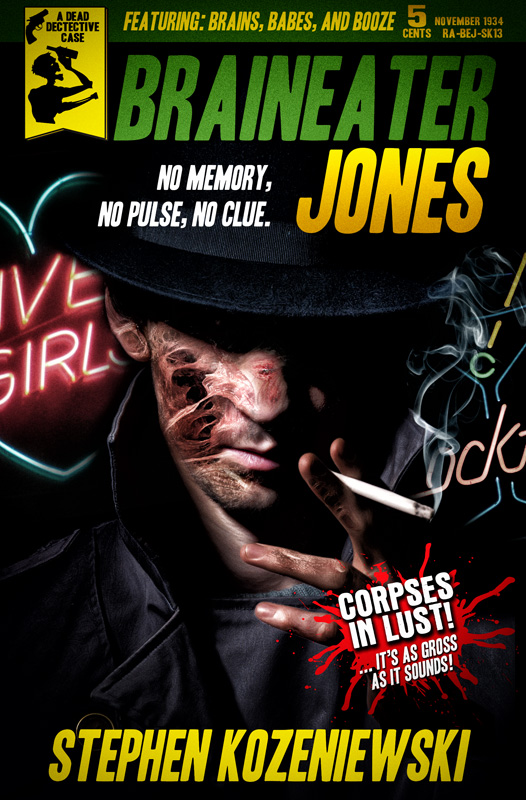When I set out to write my debut, BRAINEATER JONES, I had a vague sense of how a hardboiled Depression-era detective talked from cartoons and movies and the like. I developed a voice in my head, essentially, that cranked out some purple prose, sprinkled intermittently with spoonerisms, malaprops, and (what I thought were) era-appropriate pop culture references.
Editing my first draft was something of a revelation. The novel is set in 1934, so that was a hard stop for all slang and references. That reference to Jiminy Cricket? Nope, that had to go. (Pinnochio didn’t come out until 1940.) What about “out the wazoo?” Doesn’t that just scream ’30s PI? Nope. Actually the term didn’t come into use until the late ’60s.
Here’s maybe the hardest of all: graffiti. Yeah, graffiti. It’s an old term in Italian, but it didn’t come into English usage until the 50’s at the earliest. I used graffito-tagging extensively to establish a sense of place in my novel, and to mark off the territory of various gangs. I mean, surely they still had street art in the ’30s. But what on earth did they call it back in the day?
(If you’re dying to know – I know you’re probably not – I cheated. I used “graffito-tag” once or twice in the book to make it clear to modern audiences what I was talking about and justified it by saying there was a large Italian immigrant population. Then the rest of the time I just said “marked” or “tagged.”)
So, yeah, despite the obvious limitations, 1930s slang is a fun and wacky argot to attempt to master. I’ve had a lot of readers say it was their favorite part of the book (or, at least, that it was not too distracting.) Since the readers like it so much, and Zohar was kind enough to invite me on the blog, I thought I’d go over a couple of the bigger categories of slang that I encountered in my “exhaustive” “research” into the subject.
1. Weapons
Well, let it never be said that folks in the ’30s were disinterested in guns. I found it interesting how many terms there were for firearms. There were actually a lot that we still use today, in fact surprising me that some weren’t more modern – “piece,” “gat,” “heater,” etc. One of the weird proclivities was to downplay the deadliness of your weapon by calling it a “bean-shooter” or saying you’re “wearing iron” and so on. Perhaps my favorite era slang term was “squirt metal.” That means you were burning powder, see? It means you plugged a guy, get it?
2. Pretty women
Yeah. So. 1930s. Not the most enlightened time. AT ALL. Women were pretty much completely objectified. When I hear “dame” now, I assume someone’s being ironic. But apparently back in the day they actually said that, as well as “broad,” “skirt,” and “twist.” “Ginchy” I actually think is a neat term that we should maybe bring back into style that I guess means “pretty and cool.” Then there’s the body parts. Apparently “hiney” as a term for the female posterior originated in the ’30s. (Sorry, Heineken.) And the legs! I could practically write a separate entry for legs. The men of the 1930s must have had quite a leg fetish to come up with terms like “gams,” “uprights,” “pins,” “pillars,” or even (my personal favorite) “getaway sticks.”
3. Money
This was another fun one. So many terms for money! I’m obviously way underqualified to psychoanalyze an entire generation, but if I had to guess, I’d say the Depression probably made the average joe on the street focus overmuch on his billfold, and thus a whole plethora of slang terms was born. A “butter-and-egg man” was rich. (You know, because he could actually afford to buy luxuries like butter and eggs.) A “fin” is a five dollar bill. A “clam,” “smacker,” or “smackeroo” is a one. (I’ve heard a few of those in modern times, but not very often and usually ironically.) A “five-and-ten” is a sort of proto-department store where you can get things for (you guessed it) a nickel or a dime. And money itself! “Cabbage,” “dough,” “bacon,” “bread,” “folding green,” “kale,” and “lettuce” all originated in the ’30s. Almost all foodstuffs, you know? I think that’s probably telling about the Depression, too.
Well, I could go on and on, but that’s probably a nice overview. If you’re really interested in 1930’s slang, check out the glossary at the end of my debut novel, BRAINEATER JONES. You can also hit me up on social media and maybe we can have a zozzle and jaw a bit about it until we’re a couple of swacked eggs.
ABOUT THE NOVEL
Braineater Jones wakes up face down in a swimming pool with no memory of his former life, how he died, or why he’s now a zombie. With a smart-aleck severed head as a partner, Jones descends into the undead ghetto to solve his own murder.
But Jones’s investigation is complicated by his crippling addiction to human flesh. Like all walking corpses, he discovers that only a stiff drink can soothe his cravings. Unfortunately, finding liquor during Prohibition is costly and dangerous. From his Mason jar, the cantankerous Old Man rules the only speakeasy in the city that caters to the postmortem crowd.
As the booze, blood, and clues coagulate, Jones gets closer to discovering the identity of his killer and the secrets behind the city’s stranglehold on liquid spirits. Death couldn’t stop him, but if the liquor dries up, the entire city will be plunged into an orgy of cannibalism.
Cracking this case is a tall order. Braineater Jones won’t get out alive, but if he plays his cards right, he might manage to salvage the last scraps of his humanity.
PURCHASE LINKS
Amazon – http://www.amazon.com/
Audible – http://www.audible.com/pd/
 ABOUT THE AUTHOR
ABOUT THE AUTHOR
Stephen Kozeniewski lives with his wife and two cats in Pennsylvania, the birthplace of the modern zombie. He was born to the soothing strains of “Boogie With Stu” even though The Who are far superior to Zep, for reasons that he doesn’t even really want to get into right now.
During his time as a Field Artillery officer he served for three years in Oklahoma and one in Iraq, where, due to what he assumes was a clerical error, he was awarded the Bronze Star. The depiction of addiction in his fiction is strongly informed by the three years he spent working at a substance abuse clinic, an experience which also ensures that he employs strict moderation when enjoying the occasional highball of Old Crow.
He is also a classically trained linguist, which sounds much more impressive than saying his bachelor’s is in German.
CONTACT LINKS
Amazon – amazon.com/author/kozeniewski
Facebook – https://www.facebook.com/
Twitter – https://twitter.com/outfortune
Goodreads – https://www.goodreads.com/
Blog – http://manuscriptsburn.
Mailing List – http://kozauthor.campayn.com/


3 Comments
Thanks for having me, Zohar!
Awesome and funny post. I had to look up the word, “argot”, thought. Educational too!
Argot you with that one, eh?